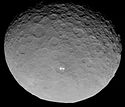Haulani (crater)
 Haulani imaged by Dawn from LAMO | |
| Feature type | Central-peak impact crater |
|---|---|
| Location | Ceres |
| Coordinates | 5°20′N 10°35′E / 5.34°N 10.58°E[1][2] |
| Diameter | 34 kilometres (21 mi)[3] |
| Discoverer | Dawn |
| Eponym | Haulani, Hawaiian goddess of plants |
Haulani /haʊˈlɑːni/ is an impact crater located on Ceres that contains "Spot 1", one of the bright spots observed by the Dawn spacecraft. The crater was named after Haulani, the Hawaiian goddess of plants.[1][2] In July 2018, NASA released a comparison of physical features, including Haulani crater, found on Ceres with similar ones present on Earth.[4]
Geology[edit]

Haulani is located near the western edge of a plateau, with two small dome-shaped mountains—Dalien Tholus and an unnamed mountain—bordering the crater to the west. Haulani is surrounded by an extensive bright ejecta blanket that extends preferentially westward, with crater rays extending up to 490 kilometers from Haulani's center. Structurally, Haulani's floor is dominated by a smooth plain, with the floor interrupted by cracks and pit chains to the northwest. An east-west mountainous ~21.8 km long and up to 300 m high occupies Haulani's center. As with many craters on Ceres, Haulani has experienced extensive mass wasting, with landslide deposits from the crater rim covering parts of its floor. It is one of the youngest large craters on Ceres, estimated to have been formed between 1.7 and 5.9 million years ago. As a result, it is one of Ceres's brightest surface features.[3][5]
See also[edit]
References[edit]
- ^ a b Staff (6 July 2015). "Planetary Names: Crater, craters: Haulani on Ceres". USGS. Retrieved 16 July 2015.
- ^ a b Staff (13 July 2015). "USGS: Ceres nomenclature" (PDF). USGS. Retrieved 16 July 2015.
- ^ a b Krohn, Katrin; et al. (December 2018). "The unique geomorphology and structural geology of the Haulani crater of dwarf planet Ceres as revealed by geological mapping of equatorial quadrangle Ac-6 Haulani" (PDF). Icarus. 316. Elsevier: 84–98. doi:10.1016/j.icarus.2017.09.014. S2CID 125918420.
- ^ Landau, Elizabeth; McCartney, Gretchen (24 July 2018). "What Looks Like Ceres on Earth?". NASA. Retrieved 25 July 2018.
- ^ Tosi, Federico; et al. (10 April 2018). "Mineralogy and temperature of crater Haulani on Ceres". Meteoritics & Planetary Science. 53 (9). Wiley-Blackwell: 1902–1924. doi:10.1111/maps.13078. S2CID 134355068.


